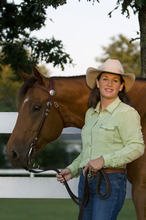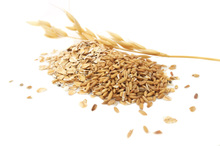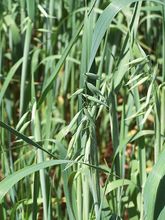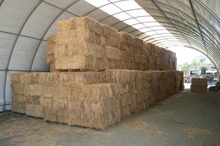Choosing grain for a horse's diet can be challenging. Feed stores carry an endless supply of specifically formulated feeds with varying protein levels and additives including vitamins and minerals. Each one is specially designed for horses in a specific age group or performance level.

Julie Goodnight
Julie Goodnight is a popular equine clinician, and also hosts a popular horsemanship television show.
© 2008 by Heidi Melocco
A simpler alternative is oats. This grain, available whole, rolled or steamed, is good for horses of all ages and all activity levels.
"Oats are all natural and a whole grain that is closest to the horse's natural diet," said Julie Goodnight, host of the television show "Horse Master with Julie Goodnight and member of the Equine Oat Research Advisory Board.
Oats are also free of additives, extra sugars and do not contain GMOs (genetically modified organisms). "Horses fed oats eat slower and chew more, which stimulates saliva and good digestion," she added.
A processed oat (crimped or steamed) improves digestibility for older horses with poor teeth, but a young horse with good teeth can chew well and eat the grain in its unprocessed state.
“In an old preference trial done many years ago oats were preferred (by horses) over other cereal grains,” Robert Coleman, Assistant Professor at the University of Kentucky, Department of Animal Sciences said. As any horse owner knows, feeds can be expensive and you want to feed something the horse will eat in its entirety.
Easily digestible
Horses have been eating oats for thousands of years and are able to easily digest the grain.

Oat grain
Oats are a traditional grain popular with horses because of its ease of digestion, and a good balance of protein, fat and starch.
"The digestibility of the oat is good and does not need to be processed to have a high level of starch digestion," Coleman explained. "Oat starch is readily available to the horse and because of this horse owners need to make sure they feed what is needed to meet a horse's calorie requirements."
"The higher fiber content reduces the calorie content of the feed which has given the oat the reputation of being a slightly safer feed for horses," he added. It takes a larger ration of oats than corn for a horse to receive the same number of calories per feeding.
When introducing a new feed or changing a horse's feed ration, always do so gradually. "Add a small amount of oats if you feed vitamin supplements, just enough to carry the supplements," Goodnight suggested. "If a horse needs additional concentrates in his diet because he is young, old, in hard work or poor condition, start with a small amount and increase gradually over several weeks."
Remember, there are many variables that determine how much a horse will need. This includes the horse's size and age, the type/quality of the hay or forage and the horse's work-load.
"Look at the forage offered (hay or pasture) and add oats to balance the calorie needs of the horse," Coleman said. "If the horse is receiving enough calories to meet its requirements from the forage being fed then no oats are needed and no oats should be fed."
Oat Hay
In addition to feeding oats as a grain ration, oat hay can make a good forage for horses. Oat hay is high in fiber and the oats are already included in the feeding.

Oat grass
Oat grass is a common forage in the Western United States. In this region, oats are dry-farmed for use as a cattle and horse feed.
"Horses love it because there is a surprise in almost every bite," Goodnight said. "It's also a great hay if you can find it. An oats/alfalfa mix is much richer and higher in protein, but great for growing horses and brood mares. It also works well as bedding, just as straw does."
Goodnight cautions that barley hay looks like oat hay and is often grown in the same areas. However, barley hay should never be fed to horses. "Barley cannot be fed whole to horses because the husks will burrow into the skin and gums and cause awful sores," she explained.
"The nutritional value will be depended on the stage of maturity the crop was at harvest" Coleman said.
When compared to alfalfa cut at the same level of maturity as oat hay, oat hay is lower in crude protein and lower in digestible energy. That being said, the horse needs to eat more pounds of dry matter per day to meet it's requirements.
"For those horses that are confined, chewing on oat hay might provide enough chew time to reduce other behaviors that owners would prefer them not to have," he said.

Oat hay
Oat hay is a good choice when available. Typically less expensive than alfalfa, oat hay is often better suited for sedentary horses because of a lower protein content.
Oat hay can be difficult to locate. Goodnight said, "Price may be a little cheaper, if you can find it. In drought years, alfalfa is usually more available and therefore cheaper, since it is a drought resistant crop."
With good quality hay and an average workload, horses probably do not need any grain supplementation. Forage is the most important part of their diet and the most attention should be paid to it. Buying hay—oat, alfalfa or grass—is entirely dependent on the availability in your area and what is grown.
Goodnight emphasizes that you have to consider cost and quality to determine what is the best hay to feed. She avoids alfalfa because of its high protein and she prefers straight grass hay, but buys oat hay when it is available and put up well.
"In my opinion, if oats have been proven to provide cardiovascular benefits for humans, it stands to reason they are good for horses too." She concluded, "If I am going to add concentrates to a horse's diet, I use whole oats (or crimped oats for seniors)."
Dig deeperTM
Learn more about Julie Goodnight by visiting her website. For more information about oats as a food for horses and other animals, please visit the Equine Feed Oat Project.
